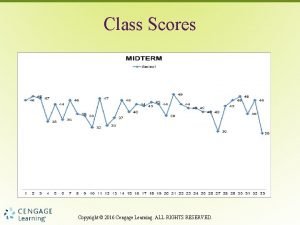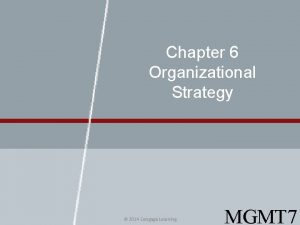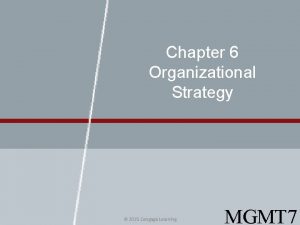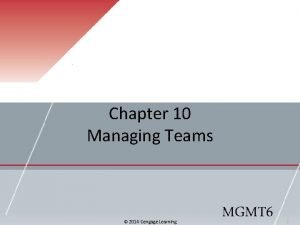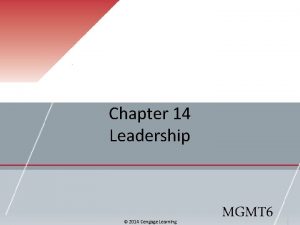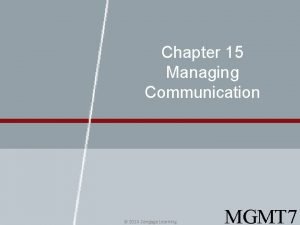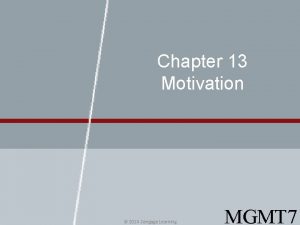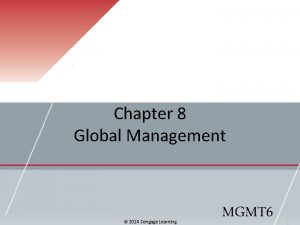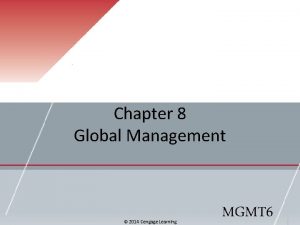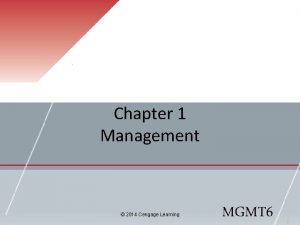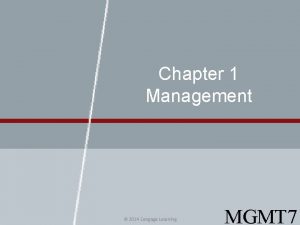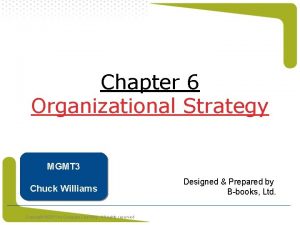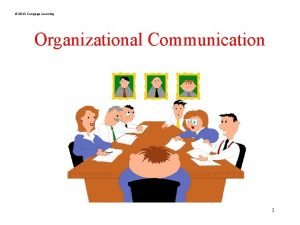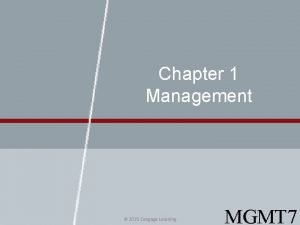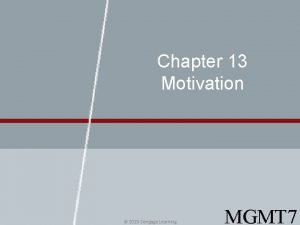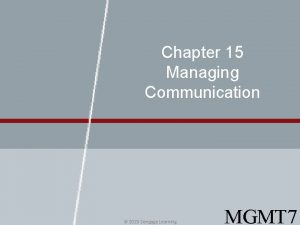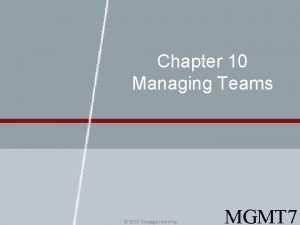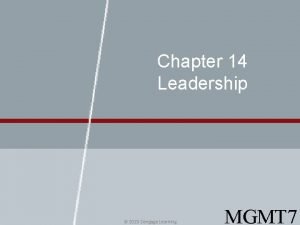Chapter 6 Organizational Strategy 2014 Cengage Learning MGMT


























- Slides: 26

Chapter 6 Organizational Strategy © 2014 Cengage Learning MGMT 6

6 -1 specify the components of sustainable competitive advantage and explain why it’s important 6 -2 describe the steps involved in the strategy-making process 6 -3 explain the different kinds of corporate-level strategies 6 -4 describe the different kinds of industry-level strategies 6 -5 explain the components and kinds of firm-level strategies © 2014 Cengage Learning

Competitive Advantage • Resources – assets, capabilities, processes, employee time, information, and knowledge that an organization controls. • Competitive advantage – providing greater value for customers than competitors can • Sustainable competitive advantage – when other companies cannot duplicate the value a firm is providing to customers © 2014 Cengage Learning 6 -1

Sustainable Competitive Advantage Resources must be… • Valuable • Rare • Imperfectly imitable • Nonsubstitutable © 2014 Cengage Learning 6 -1

© 2014 Cengage Learning 6 -2

Assess • Difficult because there is a lot of uncertainty in business. • Also, top managers are often slow to recognize the need for strategic change. – competitive inertia • Managers must be aware of strategic dissonance. © 2014 Cengage Learning 6 -2

Situational Analysis • Strengths • Weaknesses • Opportunities • Threats © 2014 Cengage Learning 6 -2

Internal Analysis • Distinctive competence – something that a company can make, do, or perform better than competitors • Core capabilities – less visible, internal decision-making routines, problem-solving processes, and organizational cultures that determine how efficiently inputs can be turned into outputs © 2014 Cengage Learning 6 -2

Looking Outside • Environmental scanning • Strategic group – group of companies within an industry that top managers choose to compare, evaluate, and benchmark strategic threats and opportunities • Core firms – central companies in a strategic group • Secondary firms – firms that use strategies related to but somewhat different from those of core firms 6 -2 © 2014 Cengage Learning

Choosing Strategic Alternatives • Risk-avoiding strategy • Risk-seeking strategy © 2014 Cengage Learning 6 -2

© 2014 Cengage Learning 6 -2

Corporate Level Strategy “What business or businesses are we in or should we be in? ” © 2014 Cengage Learning 6 -3

Portfolio Strategy A corporate-level strategy that minimizes risk by diversifying investment among various businesses or product lines. Companies can grow through: • acquisitions • unrelated diversification © 2014 Cengage Learning 6 -3

© 2014 Cengage Learning 6 -3

© 2014 Cengage Learning 6 -3

Grand Strategies Broad strategic plans used to help an organization achieve its strategic goals • Growth strategy • Stability strategy • Retrenchment strategy – make significant cuts – recovery 6 -3 © 2014 Cengage Learning

Industry-Level Strategies “How should we compete in this industry? ” © 2014 Cengage Learning 6 -4

© 2014 Cengage Learning 6 -4

Positioning Strategies • Cost leadership • Differentiation • Focus © 2014 Cengage Learning 6 -4

Adaptive Strategies • Defenders • Prospectors • Analyzers • Reactors © 2014 Cengage Learning 6 -4

Firm-Level Strategies “How should we compete against a particular firm? ” © 2014 Cengage Learning 6 -4

Direct Competition The rivalry between two companies offering similar products or services that acknowledge each other as rivals and take offensive and defensive positions as they act and react to each other’s strategic actions. • Market commonality • Resource similarity © 2014 Cengage Learning 6 -5

© 2014 Cengage Learning 6 -5

Strategic Moves of Direct Competition • Attack – a competitive move designed to reduce a rival’s market share or profits • Response – a countermove, prompted by a rival’s attack, designed to defend or improve a company’s market share or profit © 2014 Cengage Learning 6 -5

Field of Dreams 1. 2. 3. <click screenshot for video> If you were Ray, what would you do in this situation? Would you be more likely to take Mark’s advice or Karin’s? If Ray decides to do what his daughter Karin suggests with the field, could you call that an example of entrepreneurship? Intrapreneurship? What are the risks Ray faces if he acts on Karin’s suggestion? © 2014 Cengage Learning

Theo Chocolate <click screenshot for video> 1. Evaluate Theo’s new strategy in light of the company’s strengths, weaknesses, opportunities, and threats. 2. Using the BCG Matrix, explain Theo’s decision to offer a classic line of chocolate bars after having limited success with Fantasy Flavor chocolates. 3. Which of the three competitive strategies— differentiation, cost leadership, or focus—do you think is right for Theo Chocolate? Explain. © 2014 Cengage Learning
 2014 cengage learning accounting answers
2014 cengage learning accounting answers 2014 cengage learning
2014 cengage learning 2009 delmar cengage learning
2009 delmar cengage learning Chapter 7 cengage
Chapter 7 cengage 2009 delmar cengage learning
2009 delmar cengage learning Medical terminology chapter 5 learning exercises answers
Medical terminology chapter 5 learning exercises answers Cengage learning heart diagram
Cengage learning heart diagram South-western cengage learning
South-western cengage learning 2009 delmar cengage learning
2009 delmar cengage learning Cengage learning heart diagram
Cengage learning heart diagram Challenge word building medical terminology
Challenge word building medical terminology Cengage learning australia
Cengage learning australia 2009 delmar cengage learning
2009 delmar cengage learning Cengage learning
Cengage learning Cengage learning
Cengage learning Wadsworth cengage learning
Wadsworth cengage learning Cengage learning
Cengage learning Cengage learning plant cell
Cengage learning plant cell Cengage learning
Cengage learning Cengage learning
Cengage learning Brooks cole cengage learning
Brooks cole cengage learning Cengage chapter 7
Cengage chapter 7 Cengage learning
Cengage learning Cengage learning
Cengage learning Chapter 6 the skeletal system answer key
Chapter 6 the skeletal system answer key Cengage learning
Cengage learning Chapter 10 cultural diversity
Chapter 10 cultural diversity























